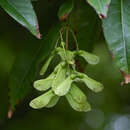fr
noms dans le fil d’Ariane


Acer laevigatum, the smooth maple or Nepal maple, is an atypical species of maple native to southern China (Guizhou, Hong Kong, Hubei, Shanxi, Sichuan, Xizang, Yunnan), northern India (Arunachal Pradesh, Sikkim), northern Myanmar, Nepal, and northern Vietnam. It grows at moderate altitudes of 1,000-2,000 m, with a wet monsoon climate.[2][3]
Acer laevigatum is an evergreen tree growing to a height of 10–15 m or more, with a trunk up to 50 cm diameter. The leaves are smooth, unlobed, leathery, olive-green, and about 6–15 cm long and 3–5 cm wide, with a short 1-1.5 cm petiole. The leaves are normally persistent, and only drop in winter in unusually severe frost.[3]
The samaras are 4–7 cm long and have a purplish tone.
There are two varieties, which may not be fully distinct:[2]
This tree is only rarely seen in maple collections as it is too tender for many locations, with successful cultivation north to Ireland in Europe, and southwest British Columbia in North America.[3][4][5] One in Cornwall is 17 m tall (Tree Register of the British Isles).
![]() Media related to Acer laevigatum at Wikimedia Commons
Media related to Acer laevigatum at Wikimedia Commons
Acer laevigatum, the smooth maple or Nepal maple, is an atypical species of maple native to southern China (Guizhou, Hong Kong, Hubei, Shanxi, Sichuan, Xizang, Yunnan), northern India (Arunachal Pradesh, Sikkim), northern Myanmar, Nepal, and northern Vietnam. It grows at moderate altitudes of 1,000-2,000 m, with a wet monsoon climate.
Acer laevigatum is an evergreen tree growing to a height of 10–15 m or more, with a trunk up to 50 cm diameter. The leaves are smooth, unlobed, leathery, olive-green, and about 6–15 cm long and 3–5 cm wide, with a short 1-1.5 cm petiole. The leaves are normally persistent, and only drop in winter in unusually severe frost.
The samaras are 4–7 cm long and have a purplish tone.
There are two varieties, which may not be fully distinct:
Acer laevigatum var. laevigatum Most of the species' range. Leaves glabrous (hairless). Acer laevigatum var. salweenense (W.W.Smith) J.M.Cowan ex W.P.Fang - Yunnan. Leaves pubescent (downy).Acer laevigatum, el arce suave o arce nepal es una especie atípica de arce nativa del sur de China (Guizhou, Hong Kong, Hubei, Shanxi, Sichuan, Xizang, Yunnan), norte de la India (Arunachal Pradesh, Sikkim), el norte de Birmania, Nepal y el norte de Vietnam. Crece en altitudes moderadas de 1,000 a 2,000 m, con un clima monzónico húmedo.[3][4]
Es un árbol perennifolio que crece hasta una altura de 10 a 15 metros o más, con el tronco de un diámetro de 50 cm. Las hojas son lisas, sin lóbulos, coriáceas, verde oliva, y unos 6 a 15 cm de largo y 3 a 5 cm de ancho, con un corto pecíolo de 1 a 1.5 cm. Las hojas son normalmente persistentes, y sólo baja en invierno en temperaturas inusuales y violentamente heladas.[4]
Las sámaras son de 4 a 7 cm de largo y tienen un tono violáceo.
Hay dos variedades, que pueden no ser totalmente distinta:[3]
Este árbol es muy raramente visto en las colecciones de arce, ya que es demasiado sensible para muchos lugares, con el cultivo exitoso del norte de Irlanda en Europa y el suroeste de Columbia Británica en América del Norte.[4][5][6] En Cornualles hay uno de 17 m de altura (Registro de árboles de las Islas Británicas).
Acer laevigatum fue descrita por Nathaniel Wallich y publicado en Plantae Asiaticae Rariores 2: 3, pl. 104. 1830.[7]
Acer: nombre genérico que procede del latín ǎcěr, -ĕris = (afilado), referido a las puntas características de las hojas o a la dureza de la madera que, supuestamente, se utilizaría para fabricar lanzas. Ya citado en, entre otros, Plinio el Viejo, 16, XXVI/XXVII, refiriéndose a unas cuantas especies de Arce.[8]
laevigatum: epíteto latíno que significa "dentado".[9]
Acer laevigatum, el arce suave o arce nepal es una especie atípica de arce nativa del sur de China (Guizhou, Hong Kong, Hubei, Shanxi, Sichuan, Xizang, Yunnan), norte de la India (Arunachal Pradesh, Sikkim), el norte de Birmania, Nepal y el norte de Vietnam. Crece en altitudes moderadas de 1,000 a 2,000 m, con un clima monzónico húmedo.
Acer laevigatum é uma espécie de árvore do gênero Acer, pertencente à família Aceraceae.
Thích lá bóng[1] hay ocnf gọi phong láng[2] (danh pháp khoa học: Acer laevigatum) là một loài thực vật có hoa trong họ Bồ hòn. Loài này được Wall. mô tả khoa học đầu tiên năm 1830.[3]
Thích lá bóng hay ocnf gọi phong láng (danh pháp khoa học: Acer laevigatum) là một loài thực vật có hoa trong họ Bồ hòn. Loài này được Wall. mô tả khoa học đầu tiên năm 1830.
Acer laevigatum Wall.
Клён гладкий, или непальский клён(лат. Acer laevigatum) — атипичный вид деревьев рода Клён (Acer) семейства Сапиндовые (Sapindaceae).
Естественно произрастает в южном Китае (Гуйчжоу, Гонконг, Хубэй, Шаньси, Сычуань, Тибет, Юньнань), северной Индии (Аруначал-Прадеш, Сикким), северной Бирме, Непале и северном Вьетнаме. Растёт на высотах 1000—2000 метров над уровнем моря, в областях с влажным муссонным климатом[3][4].
Вечнозелёное дерево, достигающее 10-15 м в высоту или более, с диаметром ствола до 50 см.
Листья гладкие кожистые, оливково-зелёные, лишены лопастей, около 6-15 см в длину и 3-5 см в ширину, с коротким 1-1.5 см черешком. Обычно остаются на дереве постоянно и могут опадать зимой при необычно сильном морозе[4].
Плод — парная крылатка лилового цвета 4-7 см в длину.
Признано две разновидности, которые невозможно полностью различить[3]:
Это дерево редко можно встретить в коллекциях клёнов, так как оно слишком нежное для выращивания во многих местах. На севере области его успешного культивирования достигают Ирландии в Европе и юго-западной Британской Колумбии в Северной Америке[4][5][6]. В Корнуолле растёт одно дерево, имеющее 17 м в высоту[7].
Клён гладкий, или непальский клён(лат. Acer laevigatum) — атипичный вид деревьев рода Клён (Acer) семейства Сапиндовые (Sapindaceae).
光叶槭(学名:Acer laevigatum)为无患子科槭属的植物。分布于缅甸、尼泊尔、印度、锡金以及中国大陆的湖北、陕西、贵州、四川、云南等地,生长于海拔1,000米至2,000米的地区,常生长在比较潮湿的溪边或山谷林中,目前已由人工引种栽培。
长叶槭树(中国树木分类学报)